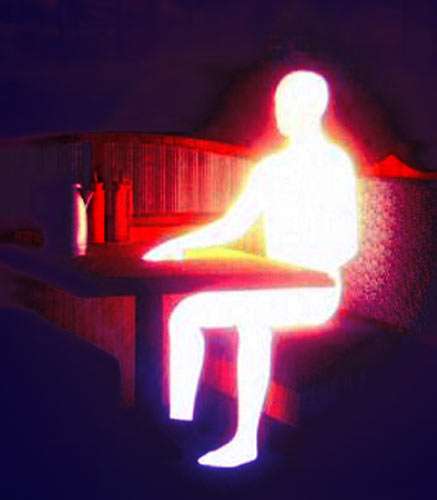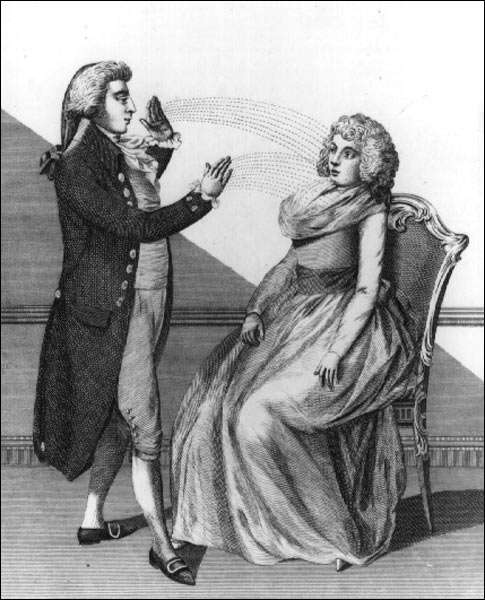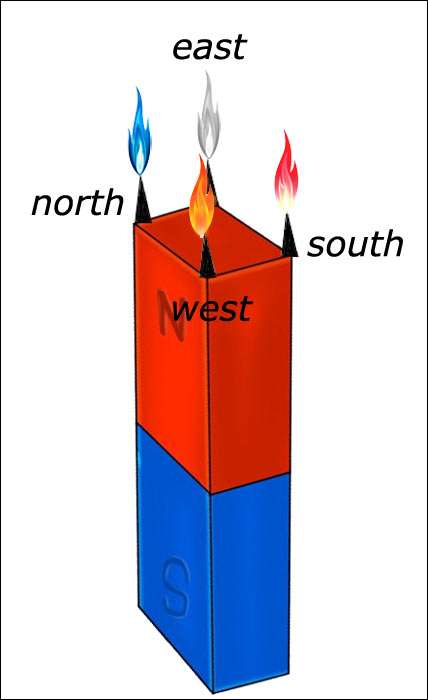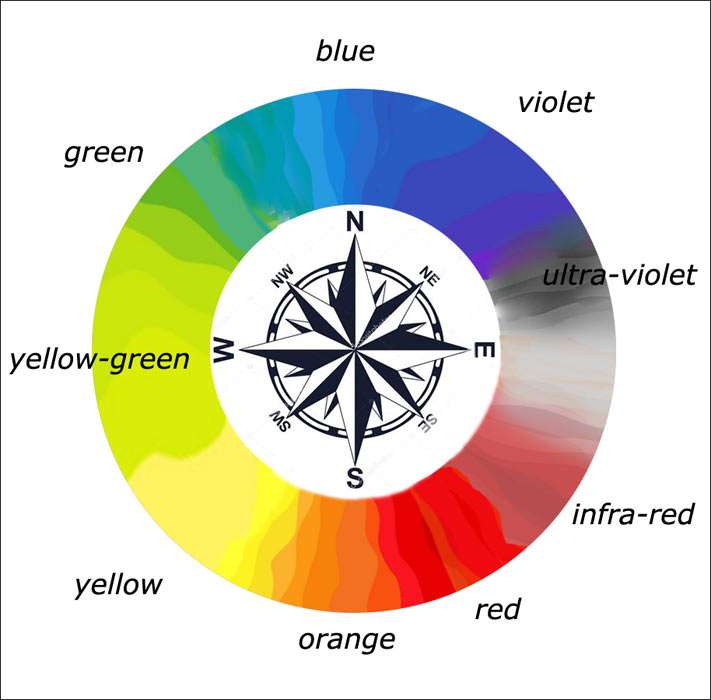
back to House of the Sun index

This article is also available in PDF format
|
In matters eternal it is Belief that makes all works visible, in matters corporeal it is the Light of Nature that reveals things invisible. Philippus Aureolus Paracelsus (alchemist, 1493-1541) |
|
Pictures in this article are my attempt at illustrating the Odic energy. Only two B/W drawings are from one of Reichenbach's books. |
Contents:
|
Reichenbach and His Sensitives The Impact of Terrestrial Magnetism
|
|
Reichenbach and His Sensitives We live in a materialistic society, where only material things are considered important. The unseen forces of life are discarded. It is all about getting things, having more, pleasure gratification, while nobody is really happy. Yet, we all have feelings of like and dislike to objects, places and people without really knowing why we like or dislike them. Scientists don't go into subjective feelings and the unseen energies that psychics, dowsers or other sensitive people talk about. These energies are a part of reality that very few investigate. One scientist did investigate in depth. In contrast to his fellow scientists, he took the effort and time to examine these unseen energies. Nowadays he is largely forgotten. His name is Baron Karl Freiherr von Reichenbach (1788-1896). He was a notable chemist, geologist, metallurgist, naturalist, industrialist and philosopher, and a member of the prestigious Prussian Academy of Sciences. He is best known for his discoveries of several chemical products of economic importance, extracted from tar, such as eupione, waxy paraffin, pittacal (the first synthetic dye) and phenol (an antiseptic).
In 1835, he bought the estate and castle of Reisenberg, near Vienna, and beautified them, so as to have one of the most elegant residences in the vicinity of that capital. The Freiherr term in his name was added later and is a term of nobility, and corresponds to the term Baron. It was imparted to him in 1839 by the king of Wirtemberg. After investigating of the pathology of the human nervous system, he found that such maladies were associated by extremely sensitive people. In 1844 he went to see a somnambulist, expecting to detect an impostor, and hoping to expose her. However he found that the condition of the somnambulist was genuine. He started studying what those sensitive people were feeling and seeing, and this led to his discovery of another force in nature that he called 'Od'. He wrote several books of his experiments and findings, three of which were translated in English (links at the end of this article). Reichenbach was very interested in what those sensitive people could feel and see what ordinary people could not. For that he worked with 162 people who were sensitive to various degrees. They were from all classes, ages and both sexes. He would test people by passing a strong magnet along the back of the person, without the person knowing when he would move the magnet van head to toe. Sensitive people would feel a warm breath of air, or sensations of drawing, prickling, or creeping. Some would complain of sudden attacks of headache. He found that those people who were sensitive usually had sedentary habits, were depressed, had troubles or anxieties, and were usually diseased. Those who are seriously ill of have certain ailments were most frequently sensitive to the magnets, especially those with nervous ailments. These people were often very sensitive to certain substances, objects, colors etc., to the point that they would become nauseated and sick. But some could also see light emanating from objects in the dark. For that purpose Reichenbach created a dark room in his castle. The room had to be absolutely dark. Even the smallest amount of ordinary light coming in would render the special sight of the sensitive useless. Some sensitives had to stay in the dark for a few hours before they could see the mysterious light emanating from objects. Others, who were more gifted, saw the light shortly after being in the dark. The least sensitive people could see the light in small quantities or sizes, while a few could larger amounts of this Odic light. Everything was meticulously described and recorded. All sensitives reported the same phenomena. Occasionally, but few, perfectly healthy people would be able to feel the passes of the magnets. Reichenbach worked also with somnambulists (sleepwalkers) because they were found to exhibit an extraordinary exaltation of the sensuous perceptions. Among other abilities, they could perceive in great darkness not only the outlines of objects, but also distinguish their colors. Reichenbach also had some healthy people who were strongly sensitive to the feeling of Odic energy, but they could hardly or not at all see any light emanations in the dark. Each sensitive was not aware of what other sensitives had felt or seen. yet the all reported the same phenomena. In the case of somnambulists, he only worked with them in their conscious state. Somnambulists can sense and perceive during their somnambulistic state too but Reichenbach wanted to avoid this as it might be considered not reliable. What follows here is a summary of his findings. In the second part of his book Dynamism of Magnetism he gives all the details of all the observations made by all his subjects. The observations of the sensitives differ from person according to their degree of sensitiveness.
Reichenbach started out with crystals and was perplexed with what the sensitives experienced. When a sensitive holds his left hand at or near the point of the crystal, he feels a fine cool breath blowing against his hand, while from the butt end, there is a warm breath. The sensitive describes the warm breath as disagreeable, almost nauseating, which would soon penetrate the whole arm, and cause a feeling of exhaustion. It is important to know that the feeling of the energy was always done with the left hand, and all the reactions described hereafter are from this left hand. The reactions are opposite when done with the right hand. Coolness and warmness are not absolute effects but only relative, and relating only to one side of the body; on the other side the sensation is reversed. The coolness and warmness are sensations which are not coming from normal temperature, heat or cold, be it from fire or ice, or sunshine etc. In the dark, the point of the crystal emits a bluish flame, waving and flickering, and sometimes sparkling, and eventually turning into a fine vapor. The blunt end of the crystal emits a dull yellowish red smoke. The entire crystal itself is pervaded with a mild light; this last feature is also true for all other objects.
Reichenbach experimented with other crystals and substances and discovered that all quartz crystals display a blue and red end, and that these are at the poles of the primary axis of the crystal. Other crystals were found to have additional, although weaker, polar axes. When magnetic passes with crystals were made on the sensitive, they produced various feeling of heat and cold sand sometimes spasms. Even healthy people could feel it. It seems that every crystals acts on the nervous system of the human body, and thus is felt weakly in healthy persons, strong in the diseased, and strongest in the cataleptic (nervous condition characterized by muscular rigidity and fixity of posture regardless of external stimuli, as well as decreased sensitivity to pain).
What you have to keep in mind for the rest of this article, is that the Odic energy is dualistic, that is, we can speak of two poles. In regards to color we find the red-yellow-orange on one side, and the blue-violet (Reichenbach never used the color indigo, maybe because the sensitives didn't distinguish indigo from blue) on the other side. usually the red and blue color is seen, but in other cases the yellow-orange or violet shows up. This division of colors is related to the two end of the color spectrum (rainbow), with green in the middle. Reichenbach started using the term od-positive for the red-yellow-orange pole and od-negative for the blue-violet pole, but I have avoided these terms here. It is easier to visualize the duality in colors than with + and -.
What was really surprising to Reichenbach was the effect of sunlight on the sensitives. When the person stands in the shadow, and holds a glass or wooden rod in the sunlight, his hands feels a cool sensation. When he pulls he rod back in the shadow, it will feel warm. An energy, similar to the point of a crystal is transmitted from the sun through the rod to the hand. It is not the warmth of the familiar solar radiation, but a different energy of an Odic nature. When one end of a copper wire is placed in sunlight and the other end in the dark room, the solar Odic energy is transferred through the wire and visible in the dark room as a flame coming out of the end of the wire. When using a prism to separate the colors out of the sunlight, when the sensitive puts his finger in the blue or violet color he feels a cool and agreeable sensation; in the yellow or red he feels a warm feeling that makes his entire arm heavy. Reichenbach deduced that the blue-violet and yellow-red light Odic light that is seen with crystals is continuously streaming down from the sun. When Reichenbach would go out into the sunlight for ten minutes, and then go into his dark room where his sensitive was waiting, the sensitive would immediately feel a much greater Odic force coming from his body. Reichenbach's body was clearly charged up with solar Odic energy. Inert bodies lying in the sun also acquire a solar charge. Working with candles, Reichenbach discovered that the sensitives would also feel a strong coolness coming from candles. One sensitive would feel this coldness pervade her whole body when a candle was brought close to her. The same happened with an argand lamp (a kind of oil lamp). From this he concluded that the light from the flames produces the same Odic energy as from the sunlight, and that Od is produced by all kinds of light.
If water sits in the blue-violet light (refracted from a prism) it will taste agreeable and sourish. If it sits in the yellow-red light it tastes nauseating and bitterish. So the quality of the Odic color is transferred into the water.
He did the same experiments as with sunlight. Moonlight gives a warm sensation to the sensitive. He then concluded that Od is a cosmic force that fills the entire universe. Having his most sensitive person feel out the night sky, Reichenbach found that the entire night sky in general and the stars feel cool, but all the planets, which reflect sunlight, feel warm. This cosmic Odic energy has a strong effect on the sensitive's body, especially her head and her spine. Reichenbach concluded that we are energetically connected to the universe.
Some sensitives who were brought in the dark room where there was a powerful magnet, would immediate have muscle spasms, fall asleep or become unconscious. Those who remained alert were very elated to the light phenomena of the magnet. Reichenbach was really fascinated by the luminous displays of magnets. He found that the Odic light appeared in five forms, producing different sensuous impressions: 1. Incandescence 2. Flame 3. Threads, streaks, and nebulae 4. Smoke 5. Sparks 1. Incandescence Incandescence is the term he used to describe a weak white glow that permeates and envelops the magnet, with two colors at either side. When a magnet is lined up with the Earth's magnetic field, its north pointing to the North Pole, then the magnet's north pole blows a cool wind upon the hand of the sensitive, while the south pole feels feels warm and is disagreeable. Here we find the same effects as with the crystal. The effects of water sitting at the magnet's north or south pole are also the same. When a magnet is viewed in the dark, some interesting light effects can be seen. The more sensitive the person was the greater the amount of light was seen. Both ends of a magnet display light and fiery flames, smoking and sparkling. At the north pole they have a blue color, and at the south pole they have an orange/red color. |

|
The following B/W figure is from Reichenbach's book. This is what the sensitives were seeing. The flames at the ends are of the colors previously described. The short rays at the sides are emanations of white light as the magnet (and every other object) is always permeated and bathed in a diffuse Odic light, which Reichenbach terms luminescence. Some sensitives can see short light emanations on the side as rainbow colors, with green in the middle. When the magnet is turned horizontally and facing the other cardinal direction, the sensitives observe a diminution of the Odic flames: they both become of duller aspect, less luminous, more dim, shorter and narrower, and moreover modified in color. |

|
He was able to capture the Odic light of a bar magnet by laying it on a photographic plate (iodized plate, exposed to mercurial vapors) for 64 hours, thus proving that there it is a material energy or force. If the magnet stands up, vertically, then the upper pole will emit a flame that grows longer and will even cast a light circle on the ceiling. Reichenbach brought a large horseshoe magnet into the dark room and the result were even more spectacular: "The Odic light will be more beautiful if you use a horse-shoe magnet, and set it upright, with both poles turned upwards. I have a nine-leaved horse-shoe magnet, with a power of raising a hundred pounds ; and all sensitive persons can see a fine light streaming out of each pole—that is, two lights side by side, which do not attract, nor influence, nor extinguish each other—as do the magnetic forces of opposing poles — but steadily stream up high, side by side, and form a light-column, as large as a man and composed of innumerable light sparkles in constant motion—the column being described as impressively beautiful by all who have seen it. It rises perpendicularly to the ceiling, and there casts a light upon a space about twelve feet in diameter. If the magnet is kept long in this position before the sensitive person, the whole ceiling becomes gradually visible. Such a magnet upon a table, throws a light upon it, so that everything on its surface can be seen for a yard in each direction from the magnet. A hand interposed between the flame and the table, casts a perceptible shadow. If you hold a piece of board, a pane of window-glass, a plate of tin, or any similar body horizontally into the flame, the latter will bend under it and rise up at the sides, just as the flame of a fire would under the same circumstances. If a draft of air blown upon the magnet, or if it be moved, the flame bends to one side as the flame of a candle would. The light can be collected in a focus by a burning glass, like the rays of ordinary light. The phenomenon is thus shown to be a material one."
drawing from Reichenbach's book It should be mentioned that when the poles of the horseshoe magnet were closed, the lights from the poles disappeared, but the light (a short flame-like luminosity, with a constant undulating motion) around the armature remained. 2. Flames Luminescence is the weakest degree of the Odic light. Flames are the same Odic light in more intense form. Luminescence is usually seen first. Flames are seen by those people who are more sensitive. In the figures above you can see the blue and red flames at the poles of the magnet. Flames are always present but not always seen. If a horseshoe magnet is strong enough, a sensitive person can see the flames rising up from its poles several feet high, and both flames will blend together to one column. When the poles of the magnet are turned downward, the light flames flow downward in the identical shape in which they flow upward, and in each direction sideways when the magnet is held that way. The intensity of the flames can vary from very weak to very strong. Flames are in constant motion. In very strong magnets, lying in the horizontal plane, the flames come out of the poles horizontally, but at a certain distance, they bend vertically upwards, showing that the Odic light is of a substance lighter than air. The flames are the result of the force with which the Odic light comes out of the magnet. Reichenbach concluded that the Odic light emanations are material or have a material substratum to it, but it is still something different than ordinary matter. It seems to be a compound of some kind of materiality united with the immaterial essence of the light. 3. Threads, streaks, and nebulae Sometimes a magnet was seen to emit lateral streaks and brushes, between the poles, on the side of the magnet. The space between the limbs of a horseshoe magnet was seen as filled with threads of flame. Magnets can be seen as enveloped by a fire-mist like vapor, sometimes streaked. Almost all the highly sensitive people would describe isolated colored threads in the Odic flames. Reichenbach thought that these were probably the result of imperfection or unevenness in the surface of the magnets. 4. Smoke Sensitives would also see a smoke ascending from a magnet. It is a a peculiar luminous vapor. It can be rather weak, but also in abundance, creating a cloudy luminosity around the magnet. It was also seen to be emitted in waves, or whirling up in clouds. Some sensitives would only see the smoke at one or both poles. The luminosity of the smoke is strongest at the poles, and weak on the sides of the magnet. The magnitude of the smoke is in direct relationship to the size of the Odic flames. One sensitive saw the smoke partially brilliantly colored, as if iridescent and containing sparks. The smoke can rise up to the size of a man. The Odic smoke is thrown out by magnets with a certain force, as we have seen with the flames, which gives it the first direction, but after that it exhibits a constant tendency to ascend, to flow upwards. When it reaches the roof of a room it spreads out, flowing away over it, illuminates the painting on it, and displays a certain, though short, permanence. The color of the smoke is gray but acquires a tint of the color at the poles. Reichenbach thought that smoke and flames are two manifestations of the same phenomenon, only differing in intensity. 5. Sparks Sparks are seen in the smoke, and are separately whirling about in it. They are small but vivid. They come forth from the magnets, and wander around or fly out un-orderly, diminishing in strength to brilliant point and then vanish altogether. They can be few in numbers but also in abundance. ....................... An electromagnet exhibits the same emissions of flaming light as on ordinary magnet. The experiments of Reichenbach shows that although Od can only be felt or seen by sensitive people, it is an energy or force that belongs to the material world. It seems to be of such a subtle order that it behaves like a fluid, streaming through all material things, similar to the old idea of the aether. Reichenbach is also adamant that Od is not related to magnetism, as it is a distinct energy or force in nature that appears everywhere. Od is present in plants and animals who are seen to emit a glowing mist of Odic light. There is curious effect that magnets have on cataleptic people, a nervous condition characterized by muscular rigidity and fixity of posture regardless of external stimuli, as well as decreased sensitivity to pain. Also on somnambulistic people, I mentioned that they usually fall asleep, or have pain, when a magnet is in the vicinity, even when the magnet is behind a solid wall. Reichenbach had sensitives whose hand would be attracted by a strong magnet and remained there as if attached. When he moved the magnet, the hand remained attached to the magnet, and the sensitive would even follow the magnet as such through the room, even when the person was in an unconscious state. One woman described her sensation as an irresistible attraction, which she felt compelled to follow unconditionally and involuntarily, and which she was obliged to obey even against her will. It was an agreeable sensation, as if connected with a cool gentle wind, issuing from the magnet on to the hand, which seemed to be attached to it as by a thousand fine threads, and to be drawn along by it. The attracting power of a magnet upon the hand of a sensitive person is also seen with crystals, but the crystals have to be of a large size. Mesmerism was big in the time of Reichenbach, and he could make some of his sensitives unconscious, have convulsions or spasms, by passing a magnet or crystal from head to foot, but he also could do the same with a mere empty hand. Especially the fingers had a strong effect. Thus he concluded that the Odic energy so peculiar to the magnet and crystal also resided in the human body. His sensitives could the typical glowing light-mist also with the human body. The sensitives could see all parts of the body through the clothing, all in a fine light mist. Fingers emit flame-like extension as long as the fingers themselves. |


|
The primary polarity in people is transversal. In relation to color the whole left side of the body, from face, arm, hand to leg and foot is yellowish, and the whole right side is bluish. |

|
The polarity of the human body is similar to the crystals and magnets, blue/violet on one side and yellow-red on the other side. The blue side feels cool, and the yellow side feels warm. It gets more interesting. As a point of reference, Reichenbach always asked the sensitives to touch with their left hand. When the sensitive's left hand now touches the left side of another person's body (yellow color), he gets the warm feeling. Equally so when he touches the yellow-orange-red side of a crystal or magnet. The cool sensation occurs when he feels the blue-violet Od, still with his left hand. From this Reichenbach deduced that the warm sensation happens when like polarities meet, and the cool sensation when opposite polarities meet. Touching with the right hand will have reverse effects. The right hand (blue side) touching the yellow/orange/red side of an object or person will result in a cool and pleasant sensation. Therefore, in any situation, where a person's left side (or parts thereof) touches or faces another person left side, this will be disagreeable to a sensitive. Left to right side is agreeable, because opposite polarities are facing). Some sensitives have extreme difficulties facing the same Odic sides. If something or somebody feels good or bad depends on facing/touching an unlike or like Odic color/energy. For sensitive people this is an important issue. Some dislike to shake hands, and will tear themselves loose if any one tries to hold their hands long. The cause is that these persons are sensitive and have an unpleasant feeling when their right hands are taken in the right hands of other people. They don't like it when their left side touches another person's left side. Same for right side. Any meeting of like poles creates an unpleasant feeling. Reichenbach knew several man who disliked riding a horse, by which the same sides of man and horse touches, and they were all sensitives. Same for men and women who don't like to carry their children on their backs. There are other polarities in the human body. The head is cool/blue while the abdomen is warm/red. The forehead is cool/blue, and the back of the head warm/red. There are many more minor polarities of individual organs in relation to each other, and within themselves. The Impact of Terrestrial Magnetism The Earth North pole is actually the magnetic south pole. Therefore the northern hemisphere is on the yellow-red side of the spectrum, and the southern hemisphere on the blue side. Some sensitives, in the northern hemisphere, can only sleep on their right side. There are unable to sleep in any other direction. The right side of the body is of a blue color and thus is agreeable when facing the opposite yellow-red color of the Earth. Reichenbach was confined to sensitives from Europe, and thus he deduced that the opposite is true for sensitives in the southern hemispheres, and at the equator it would not any difference. There are other polarities in the human body. The head is blue color and the abdomen is red. Therefore, when lying down in bed, they only feel comfortable with their head to the north. (head is blue, and geographical north (=magnetic south) is red. Reichenbach found that people who had lasting sleep problems were sleeping in the wrong direction, and when their bed was turned with the head to the north, they would sleep fine. Further experiments showed that sensitives are most comfortable sitting in a chair with the back to the north, and most unpleasant with the back to the west. The terrestrial magnetism stimulates in sensitive persons, healthy and sick, a peculiar exciting action, strong enough to interfere with their rest. In the healthy it modifies their sleep; in the sick it disturbs the circulation of the blood, the functions of the nerves, and the equilibrium of the vital force. Reichenbach found that cures of ailments of sensitive people were more effective and sometimes immediate when the person was properly aligned with the terrestrial magnetic field. Sensitive people like to sleep on their right side, because the right side of the body is blue and the ground is red (in the northern hemisphere). The magnetic conditions of the earth are subject to variations, and these variations are connected with the phases of the moon, among other things, in such a way that the intensity of the terrestrial magnetism attains its minimum when the moon is full. Thus its influence on people fluctuates accordingly, or rather the Odic energy associated with terrestrial magnetism, not the magnetic force itself. Reichenbach lived in the era of mesmerism, popularized by the famous Anton Mesmer. Reichenbach explains that mesmerism is just a special application of the manipulation of Odic energy. Sensitive people can feel the so-called 'magnetic' passes inches to several feet away. Reichenbach had one sensitive who could feel the passes up to 30 steps away. Odic energy from the hands or fingers of the one doing the 'magnetic' passes streams out quite a long distance, as his sensitives were seeing the light emanations in the dark. When one makes the passes in the dark, the sensitives see fiery brushes of the stroking fingers rubbing down over the body of the patient. They also see that, where these flames strike on their own bodies, a spot of stronger light appears, and moves along downwards with the course of the stroke. This Odic energy can definitely be used as a therapeutic agent in mesmerism or other methods of hands-on healing. Mesmerism was thought to be a form of animal magnetism. Reichenbach did not agree with this, as Odic energy has nothing to do with magnetism only. Od is a universal energy, present everywhere, and not limited to the animal or human body. |

Mesmerism as seen in the 18th century.
|
Reichenbach discovered that all chemical reactions and decompositions produce Od in large quantities. Depending on the chemical reaction, a feeling of coolness or of warmth was produced. When a bottle of champagne is opened in the dark, a sensitive person will see a fiery ray following the flying cork to the ceiling. The whole bottle will then appear in a white glow, as if it were of illuminated snow, and over it will be a light waving cloud. When water is stirred, the water starts glowing and filling with light. Put a metal wire in sulfuric acid and the wire starts to glow and a flame arises from its upper end. All fermenting fluids give forth a constant light. Air bubbles arise through them like glowing pearls. Putrefying substances also give out Odic light. This last observation led Reichenbach to graveyards.
He wondered if the sightings of ghosts above graves was actually related to Od. He took one of his sensitives one dark night to a graveyard. Over several graves she saw fiery apparitions and moving flames. They were all over fresh graves; old graves did not show any spectacle. Reichenbach concluded that the ghostly apparitions were the result of evaporation of different gases during the decomposition of the corpses, giving rise to Odic light which then moves with the wind. |


Pictures taken at grave in Todmorden, England. Credit: Pen News/Rob Crabtree
|
Reichenbach continued to experiment, and wondered if sound would produce Od. A bell, a metal bar or anything that rings, would produce Odic light. The louder, the more light. The body of the object, and of musical instruments, would also be filled and glowing with light. When the sensitives would place their left hand inside the ringing bell, they would feel a cool sensation, a sign that Od of a blue quality was produced. Friction of one substance against another produces the glowing and the red quality with unpleasant, nauseating feeling. In the dark sensitives noticed a metal saw, sawing a piece of wood, emitting a reddish glow, and a little flame coming from every tooth. Other substances rubbed together would produce glowing lights and fiery flames, which differed in color and size depending on the the nature of the substance. The effect would cease immediately when the rubbing was stopped. This also applies to water that is shaken. Water flowing through a funnel or pipe produces the same result. That led Reichenbach to bring a sensitive outside and walk over an underground water pipe (that only he knew about). The sensitive promptly identified the location of the pipe by the change of sensation. She felt a warm, disagreeable sensation in her left foot. He repeated the experiment with other sensitives who also were able to locate the pipe. Reichenbach concluded that dowsing is nothing but the bodily sensing of the Odic energies, and has nothing to do with the dowsing rod. Only high sensitives can see Odic light coming from all metallic furnishings, all keys, all gilded objects in their rooms, every nail on the wall. Some are brighter than others. Like any other object they are seen as filled with light as if translucent, and have a glow around them. Flame-like extensions loosing themselves into smoke can also be seen on occasion. Metals have a variety of colors. For example copper gives out a red light, sulfur a blue light. Compound substances also have colored lights. Even the stones of the room's walls were seen in light; and when the sensitives stayed long enough in the dark, they could eventually see the entire room as lighted up, being able to distinguish all objects. This reminds me of the famous case of Kaspar Houser in the 19th century. He was so sensitive that he could feel if certain metals were in a house. He could distinguish gold, brass, copper, silver and lead, based on what they ‘emit’ without seeing them directly. More complex bodies only exhibit flames at their points when they are crystallized; otherwise they are mostly either surrounded by a luminous vapor, or they are bright and luminous, as if glowing. We already mentioned that sensitives are very susceptible to Odic emanations, giving them good or bad feelings. Looking into a quicksilver (backed) mirror he will feel as if a warm, nauseating breath were blowing on him. If he keep standing in front of the mirror, he will feel pain in the stomach, get a headache and a disposition to vomit. They cannot wear copper or steel jewelry as this will also give them the unpleasant feelings. Brass, copper or iron/steel kitchen objects also have the same effect. A high sensitive can easily distinguish pure gold or silver from that alloyed with copper. Reichenbach found that dowsers could locate different metals purely by the Odic energies giving off and influencing their body or nerves.
We have seen that chemical reactions produce Odic energy, and thus digestion of the food in the body and the other chemical process that take place inside the body all produces Odic energy. The body produces one more, even stronger, source of Od. Reichenbach found that one of the strongest discharges of Odic energy is constantly going on through the breath of all living creatures because of a lively chemical action in the lungs. Every exhalation creates a cloud of luminous Odic vapor. This explains why sensitive people don't like to be in a room full of other people exhaling all those different Odic energies. They always want to open a window, even when it is cold.
Reichenbach checked out several of the then known elements for their colors. red color: copper, bismuth, zinc, osmium, titanium, sodium, arsenic, coal, iodine, selenium, rhodium, tellurium, mercury, nickel, sodium, potassium blue color: tin, lead, palladium, cobalt, sulfur, iridium white: silver, gold, platinum, antimony, tin, cadmium, diamond variegated, with the colors of the rainbow: iron yellowish green: nickel and chromium Take into account that these are not pure colors, some have additional marginal or internal colors. In compound substances, alkalis and alkaloids are red; haloid salts and most oxides and acids are blue. Organic substances are in the middle of the two poles.
On closer examination the formerly reported colors of the red and blue ends of the light spectrum are not a hundred percent these colors. When the sensitive paid closer attention, they found that these colors are the predominant colors. the other colors of the light spectrum are also present but in a much lesser amount. When the flames at either pole of a magnet are completely still, some sensitives would see a rainbow overlaid on the blue and red flames, with the blue and red dominating, according to the corresponding pole. The rainbow itself starts with the red at the bottom, then yellow, green, blue, and violet at the top of the flame. Above the violet another pure red appears. It seems that the rainbow always starts and end with red. The phenomenon was more beautiful and more clearly marked on electromagnets.
Colors and The Cardinal Directions By putting a bar magnet upright, and fixing four metal points to the top, Reichenbach found that they did not display one color, as before, but four different colors. When he turned the magnet around its vertical axis, The four flames coming out of the four points did not move with the points. When turning around every 45 degrees, the blue light always stood over the northern point; the yellow over the western, the red over the southern, and the grayish-white over the eastern. The formerly red and blue colors on opposite sides of the bar magnet were the result of the magnet being aligned with the magnetic north. The colors are not related to the poles but to the magnetic cardinal directions. |

|
The ordinal directions give mixed colors; in the north-west green, in the south-west orange, in the south-east gray-red, in the north-east violet. Instead of the four metal points, Reichenbach put a circular plate of iron on top of the magnet bar. A circular rainbow appeared. The lights streamed out on all sides of the plate. In the north all the shades of blue were visible, turning into green and all its varieties in the north-west, yellowish-green near the west, yellow, and orange, and red in the south, and gray-red, and gray in the east, changing again gradually to the blue of the north, except a clearly defined red stripe in the north-east. So we have the colors of the light spectrum, plus a gray-white area, which I think are the colors that are not perceptible with the human eye, and which the brain interprets as just white and gray. This way we have infra-red below the red and ultra-violet above the violet. The red stripe in the northeast is kind of strange. But as with the flames we have seen that the Odic rainbow starts and end with red. So here we have that again. The color wheel probably changes with the geographic coordinates. Reichenbach performed his experiments only in Germany. The rainbow feature will probably remain but it might shift with the cardinal directions. The reason why the colors of Odic energy remain constant in spite of turning the bar magnet around, is that they are linked to the terrestrial magnetism. The earth has its own magnetic field. The Odic energy coming out of the magnet will take the color that correspond to the cardinal directions. |

|
The reason why the colors of Od-energy remain constant in spite of turning the bar magnet around, is that they are linked to the terrestrial magnetism. The earth has its own magnetic field. The Odic energy coming out of the magnet will take the color that correspond to the cardinal directions.
All materials can conduct Odic energy. For that purpose Reichenbach would hold the point of a crystal to one end or side of a substance, while the sensitive would hold his hand at the other end or side. The sensitive would feel the Odic energy of the crystal immediate or at an interval of time, depending on the substance the Odic energy had to traverse. Odic conductivity is very slow in paper, wool and wood. This is because of the woven fibers. The more fibers or layers of fibers, the more it is a barrier for the Odic energy to get through. Thickly woven fabrics will block the transference of Odic energy. Cotton and wool fabric are not good for conductivity. Perfect conductivity happens in silk and glass. Metals allow for instantaneous conductivity. The point of the crystal does not even have to touch the metal, but just be close to it. In short, the conducting power depends on the continuity of the material. All tissues are worse than metals. When conduction happens through a length of wire, be it of metal or of fibers, then the Odic energy moves slowly through the wire from one end to the other.
Materials can be charged up with Odic energy from another substance. When magnetic passes are made with the point of a crystal over a material, the Odic energy will built up in this material with each subsequently pass. Maximum charge is made in a few minutes. The material will hold it charge only for a couple of minutes, with steel and water up to ten minutes. A copper plate that normally feels warm to a sensitive, and which have laid on a walnut table (walnut wood feels cool), will acquire the walnut energy for a while. When the sensitive feels the copper it will feel cool for a few minutes until the acquired cool walnut wood energy has dissipated. Therefore an object handled by a person will acquire that person's energy, and might change the sensation of that object, or the emitted light color, for a certain amount of time. The transference of the energy of one object to another does not require immediate contact but can also take place by mere proximity.
In the dark room, the sensitives could see the Odic light from object reflected in a mirror, but this reflection was usually weak, presumably because the glass of the mirror absorbs most of the Odic light. In particular cases Odic light is also capable of penetrating semi-transparent bodies. This is shown by the fact that it is still detected in the dark through closed eyelids, eye-lids being semi-transparent. Form and shape are not distinguishable, but the brightness of the Odic light is picked up.
English translations: Letters on Od and Magnetism (PDF) A good quality reprint of these books can be bought at Gyan Books: |